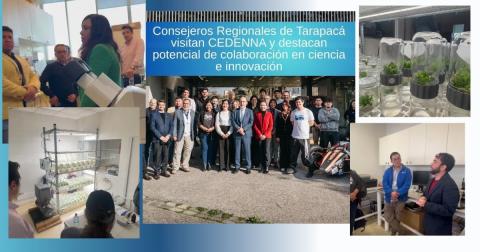
-
The delegation toured laboratories in plant nanobiotechnology, nanobiomedicine, nanosafety, and nano-structured chemistry, showing particular interest in projects for the recovery of native species and medical applications of nanotechnology.
A delegation composed of eight Regional Councilors from Tarapacá, together with the Regional Ministerial Secretary (Seremi) of Science, Technology, Knowledge, and Innovation for the regions of Arica y Parinacota and Tarapacá, Alexia Vásquez Pino, visited the Center for the Development of Nanoscience and Nanotechnology (CEDENNA) this Wednesday, in an event organized by the University of Santiago, Chile (USACH).
The purpose of the visit was to strengthen ties between the Regional Government and the scientific capabilities of the center, exploring opportunities for collaboration to promote research, development, and innovation (R&D&I) in northern Chile.
From the USACH auditorium, Rector Rodrigo Vidal emphasized the importance of ensuring that scientific developments go beyond the academic environment:
“Research should not only be developed in laboratories—it must reach out and impact society. That is what we expect. We firmly believe in scientific dissemination but also in the democratization of knowledge.”
During the visit, participants learned about four of CEDENNA’s main laboratories:
-
Plant Nanobiotechnology: research on in vitro cultivation of native species, with applications in ecological restoration, biodiversity conservation, and the production of bioactives. This work drew particular interest from Raúl Castillo, General Director of Innovation at the University of Tarapacá, who extended an open invitation for CEDENNA researchers to visit Iquique.
-
Nanobiomedicine: development of controlled drug-delivery systems and nanoparticle-based cancer therapies, with clinical potential for treating various types of cancer.
-
Nano-structured Chemistry: synthesis and characterization of materials with functional properties at the nanometric scale, including conductive polymers, hybrid materials, and compounds for applications in energy, health, and sensors.
-
Nanosafety: assessment of potential health and environmental risks associated with the use of nanomaterials, including the use of the ELPI+ instrument to characterize airborne nanoparticles. This laboratory is accredited by the National Institute of Standardization (INN) for cytotoxicity testing.
The Seremi of Science, Technology, Knowledge, and Innovation, Alexia Vásquez Pino, praised the initiative:
“Being here at CEDENNA and learning firsthand about the research being carried out is essential for broadening the perspective in each of our regions. Here, we visited laboratories linked to agriculture and medical applications, and we saw how nanotechnologies and nanoparticles can contribute to solutions for current and future diseases. This is an opportunity to think about how to build regional knowledge from the capabilities that already exist in the country.”
Regional Councilor Hugo Estica Esteban highlighted:
“I greatly value the preparation and the way we were received, as well as the opportunity to learn that this kind of technology is being developed in Chile. I am impressed, but I also have the question: how can we bring this to my region? That is the challenge I intend to address over the next four years.”
Meanwhile, Regional Councilor Lucero Callpa Flores stated:
“I am impressed by the research that has been developed here. Our great challenge is to promote technology and research in our region, aligning them with our Regional Development Strategy and our innovation and rural development policies. This could be a key strategic axis for the growth of our universities and our region.”
- Log in to post comments







